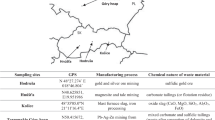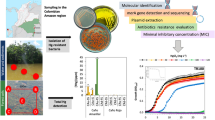Abstract
Bacteria were isolated from soil samples, containing high exchangeable lead concentrations, obtained from a busy freeway in the México City metropolitan area. Forty-five selected strains (86.7% Gram-positive) had a single MIC distribution pattern for lead (800–1600 µg/ml lead nitrate) and were considered lead-resistant. The isolates showed variable levels of resistance to arsenate (86.7%), chromate (66.7%), cadmium (57.6%), and mercury (31.1%) ions. Multiple inorganic-ion resistance was shown by all strains.
Similar content being viewed by others
References
Babich H & Stotzky G (1982) Gascous and heavy metal air pollutants. In: Burns RG & Slater JH (Eds) Experimental Microbial Ecology. (pp 631–670) Blackwell Scientific Publications, Oxford
Baez A, Rosas I, Belmont R, Gonzalez O & Gomez E (1977) Determinación de cromo en dos poblaciones no ocupacionalmente expuestas. An. Inst. Biol. Univ. Nal. Auton. Méx. 48: 77–93
Belliveau BH, Starodub ME, Cotter C & Trevors JT (1987) Metal resistance and accumulation in bacteria. Biotech. Adv. 5: 101–127
Cenci C, Morozzi G, Scazzocchio F & Morosi A (1982) Antibiotic and metal resistance ofEscherichia coli isolates from different environmental sources. Zbl. Bakt. Hyg. I. Abt. Orig. C3: 440–449
Cervantes C & Gutierrez-Corona F (1994) Copper resistance mechanisms in bacteria and fungi. FEMS Microbiol. Rev. 14: 121–138
Cervantes C, Ji G, Ramirez JL & Silver S (1994) Resistance to arsenic compounds in microorganisms. FEMS Microbiol. Rev. (in press)
Cervantes C, Ohtake H, Chu L, Misra TK & Silver S (1990) Cloning, nucleotide sequence, and expression of the chromate resistance determinant fromPseudomonas aeruginosa plasmid pUM505. J. Bacteriol. 172: 287–291
Cervantes-Vega C, Chavez J, Cordova NA, De La Mora P & Velasco JA (1986) Resistance to metals byPseudomonas aeruginosa clinical isolates. Microbios. 48: 159–163
Diels L, Sadouk A & Mergeay M (1989) Large plasmids governing multiple resistance to heavy metals: a genetic approach. Toxicol. Environ. Chem. 23: 79–89
Doelman P (1987) Resistance of soil microbial communities to heavy metals. In: Jensen V, Kjoller A & Soresen LH (Eds) Microbial Communities in Soil. (pp 369–383) Elsevier, New York
Hines Y (1987) Survival and dormancy of microorganisms. John Wiley and Sons, New York
Mergeay M (1991) Towards an understanding of the genetics of bacterial metal resistance. Trends Biotechnol. 9: 17–24
Mergeay M, Nies D, Schlegel HG, Gerits J, Charles P & Gijsegem F van (1985)Alcaligenes eutrophus CH34 is a facultative chemolithotroph with plasmid-bound resistance to heavy metals. J. Bacteriol. 162: 320–324
Mergeay M, Springael D & Top E (1991) Gene transfer in polluted soils. In: Fry JC & Day MJ (Eds) Bacterial Genetics in Natural Environments. (pp 152–171) Chapman and Hall, New York
Nakahara H, Ishikawa T, Sarai Y & Kondo I (1977) Distribution of resistances to metals and antibiotics of staphylococcal strains in Japan. Zbl. Bakt. Hyg. I. Abt. Orig. A 237: 470–476
Nakahara H, Ishikawa T, Sarai Y, Kondo I & Mitsuhashi S (1977a) Frequency of heavy-metal resistance in bacteria from inpatients in Japan. Nature 266: 165–167
Nakahara H, Ishikawa T, Sarai Y, Kondo I, Kozukue H & Silver S (1977b) Linkage of mercury, cadmium, and arsenate and drug resistance in clinical isolates ofPseudomonas aeruginosa. Appl. Environ. Microbiol. 33: 975–976
Novick RP & Roth C (1968) Plasmid-linked resistance to inorganic salts inStaphylococcus aureus. J. Bacteriol. 95: 1335–1342
Silver S (1983) Bacterial interactions with mineral cations and anions: good ions and bad. In: Westbrock P & de Jong EW (Eds) Biomineralization and Biological Metal Accumulation. (pp 439–457) D. Reidel, Dordrecht
Silver S & Walderhaugh M (1992) Regulation of chromosomal and plasmid cation and anion transport systems. Microbiol. Rev. 56: 1–33
Silver S, Nucifora G, Chu L & Misra TK (1989) Bacterial resistance ATPase: primary pumps for exporting toxic cations and anions. Trends Biochem. Sci. 14: 76–80
Stoker HS & Seager SL (1981) Química Ambiental: Contaminación del Aire y del Agua. In: Blume (Ed) Barcelona (pp 259–297)
Summers AO, Jacoby GA, Swartz MN, McHugh G & Sutton L (1978) Metal cation and oxyanion resistances in plasmids of Gram negative bacteria. In: Schlessinger D (Ed) Microbiology — 1978. (pp 128–131) American Society for Microbiology, Washington, D.C.
Summers AO & Silver S (1978) Microbial transformations of metals. Ann. Rev. Microbiol. 32: 637–672
Author information
Authors and Affiliations
Rights and permissions
About this article
Cite this article
Pacheco, S.V., Miranda, R. & Cervantes, C. Inorganic-ion resistance by bacteria isolated from a Mexico City freeway. Antonie van Leeuwenhoek 67, 333–337 (1995). https://doi.org/10.1007/BF00872931
Received:
Accepted:
Issue Date:
DOI: https://doi.org/10.1007/BF00872931




